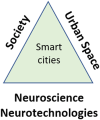Neurochallenges in smart cities: state-of-the-art, perspectives, and research directions
- PMID: 39744330
- PMCID: PMC11688368
- DOI: 10.3389/fnins.2024.1279668
Neurochallenges in smart cities: state-of-the-art, perspectives, and research directions
Abstract
Smart city development is a complex, transdisciplinary challenge that requires adaptive resource use and context-aware decision-making practices to enhance human functionality and capabilities while respecting societal and environmental rights, and ethics. There is an urgent need for action in cities, particularly to (i) enhance the health and wellbeing of urban residents while ensuring inclusivity in urban development (e.g., through the intelligent design of public spaces, mobility, and transportation) and (ii) improve resilience and sustainability (e.g., through better disaster management, planning of city logistics, and waste management). This paper aims to explore how neuroscientific and neurotechnological solutions can contribute to the development of smart cities, as experts in various fields underline that real-time sensing designs and control algorithms inspired by the brain could help build and plan urban systems that are healthy, safe, inclusive, and resilient. Motivated by the potential interplay between societal challenges and these emerging technologies, we provide an overview of state-of-the-art research through a bibliometric analysis of neurochallenges within the context of smart cities using terms and data extracted from the Scopus database between 2018 and 2022. The results indicate that smart city research remains fragmented and technology-driven, relying heavily on internet of things (IoT) and artificial intelligence (AI)-based technologies. Mostly, it also lacks careful integration and adoption tailored to societal goals and human-centric concerns. In this context, the article explores key research streams and discusses how to create new synergies and complementarities in the challenge-technology intersection. We conclude that realizing the vision of smart cities at the nexus of neuroscience, technology, urban space, and society requires more than just technological progress. Integrating the human dimension alongside various technological tools and systems is crucial. This necessitates better interdisciplinary collaboration and co-production of knowledge toward a hybrid intelligence, where synergies of education and research, technological innovation, and societal innovation are genuinely built. We hope the insights from this analysis will help orient neurotechnological interventions on urban living and ensure they are more responsive to societal and environmental challenges as well as to legal and ethical concerns.
Keywords: adaptive resource use; human wellbeing; human-centered technology; hybrid intelligence; neurourbanism; resilience and sustainability; smart city development.
Copyright © 2024 Özkaynak, Aras, Daloğlu Çetinkaya, Ersoy, Durmaz İncel, Koca, Nalça, Onay, Öncü, Ülger Vatansever, Yücesoy and Yücesoy.
Conflict of interest statement
The authors declare that the research was conducted in the absence of any commercial or financial relationships that could be construed as a potential conflict of interest. The author(s) declared that they were an editorial board member of Frontiers, at the time of submission. This had no impact on the peer review process and the final decision.
Figures








References
-
- Alam A., Gattami A., Johansson K. H. (2010). “An experimental study on the fuel reduction potential of heavyduty vehicle platooning,” in 13th International IEEE Conference on Intelligent Transportation Systems (Funchal: IEEE; ). 306–311.
-
- Allam Z., Dhunny Z. (2019). On big data, artificial intelligence, and smart cities. Cities 89, 80–91. 10.1016/j.cities.2019.01.032 - DOI
-
- Alter S. (2020). “How facets of work illuminate sociotechnical challenges of Industry 5.0,” in Proceedings of ECIS 2020 (Marrakesh: Twenty-Eigth European Conference on Information Systems (ECIS2020; )).
-
- Archdaily (2020). Superblock of sant antoni/leku Studio. Available at: https://www.archdaily.com/938244/superblock-of-sant-antoni-leku-studio (accessed June 30, 2024).
Publication types
LinkOut - more resources
Full Text Sources

